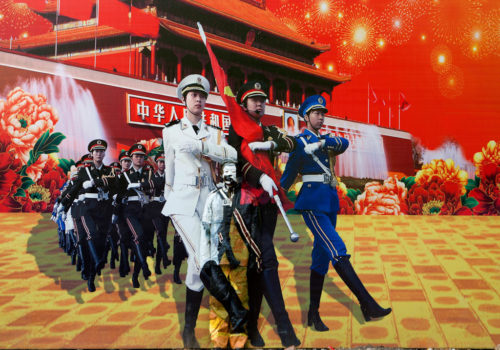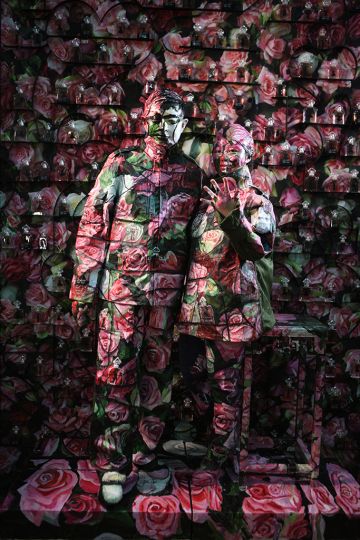Camouflage Revealed. Liu Bolin and the art of mimetic performance
His name is Liu Bolin, also known as ‘ chameleon man’. A Chinese artist of the new generation (born in 1973), Liu Bolin is specialized of stunning performances in which he perfectly disguises himself as the surroundings, constantly playing between the visible and the invisible. By making use of a number of artistic genres and techniques, ranging from sculpture to body art, from performance to photography, Liu Bolin is capable of posing for hours completely motionless. Thanks to his team of collaborators that includes painters and photographers, his body ends up completely swallowed up by the environment. No Photoshop post-production, rather, very careful body painting and a meticulous study of perspective is what makes the fine quality of his camouflages. Indeed, it is only after an extended series of snapshots that the artist finally selects what he regards as the image that best captures his evanescent presence. To spot ‘the invisible man’ out may even turn into a sort of game. Yet the origin of Liu Bolin’s camouflaging performances is anything but playful. It all began with the destruction of the artist’s atelier at the Suojia Village International Arts Camp, a Beijing suburb where hundreds of artists were based. On November 16, 2005, in the context of the works for the Olympic Games of 2008, Chinese authorities began demolishing the village, evicting its inhabitants. Liu Bolin’s series Hiding in the City tells this story. The series opens with the silent protest of a self-portrait in which an immobile artist camouflaged as bricks lies down among the ruins of his own atelier.The execution is perfect, the illusion disquieting. It is in the context of a booming China, with its unruly economic development, its massive urbanization, and the ensuing large-scale societal consequences, that Liu Bolin’s artistic production makes sense. The artist belongs to a generation born under Mao and growing up in the 1980s on the ashes of the Cultural Revolution. Originally from the Shandong district, Liu Bolin moved to Beijing in 1999, where he graduated at the Central Academy of Fine Arts, specializing in sculpture under the guidance of Sui Jianguo. At about that time, he also joined the milieu of alternative artists’ communities.
Following the model of the Beijing East Village (1993-1998), such communities enabled young artists to experiment with performance art beyond censorship and political and cultural conservatism. For his first series of urban camouflages, Liu Bolin chose some symbolically charged places in Beijing. He posed before the walls where famous propaganda slogans, such as ‘New culture needs more’ (Hiding in the City n. 03, 2005) are painted; in the middle of Tian’anmen Square below the huge Mao Zedong’s portrait (Hiding in the City n. 08, 2006); and, later, in front of the Bird’s Nest Stadium built on the occasion of the 2008 Olympic Games (Hiding in the City n. 86, 2009). The latter disappearing performance turned out to be particularly clairvoyant, since in 2011 the Stadium’s architect Ai Weiwei was arrested without warranty and has have been detained by the Chinese authorities for almost three months.
In recent years, Liu Bolin’s project Hiding in the City evolved and his research moved westward, turning into a critique of the social issues related to economic globalization, including the complex relation between civil society and financial power, ecology and the exploitation of natural resources, tradition and innovation, conservation and the destruction of heritage. In the series Hiding in Italy (2010), Hiding in Paris (2011) and Hiding in New York (2011), the artist hides himself in various surroundings, conveying a message that is each time different and which mirrors his relationship to the world, whether in terms of belonging, condemnation, empathy or flight. Liu Bolin does not resist the mainstream, rather, he dives into it and takes shelter behind it. He has described his philosophy as follows: ‘Each one chooses his or her path to come in contact with the external world. I chose to merge with the environment. Instead of saying that I simply disappear into the background, it would be better to say that the environment has engulfed me and that, consequently, I cannot afford to choose to be either active or passive’. A native of Shandong Province, Liu Bolin has lived and worked in Beijing since 1999 Silvia Mattei (translated by Andrea Mubi Brighenti)
EXHIBITION
Galerie Paris-Beijing
PARIS-BRUSSELS-BEIJING
54, rue du Vertbois
75003 Paris
France
Paris : du jeudi 10 janvier au samedi 9 mars 2013
Bruxelles : du jeudi 7 mars au samedi 11 mai 2013

















